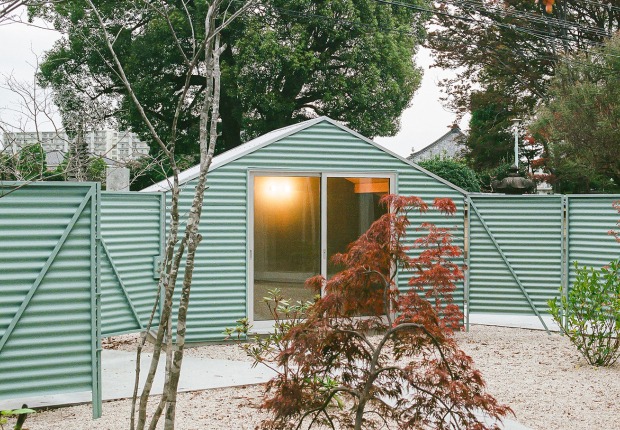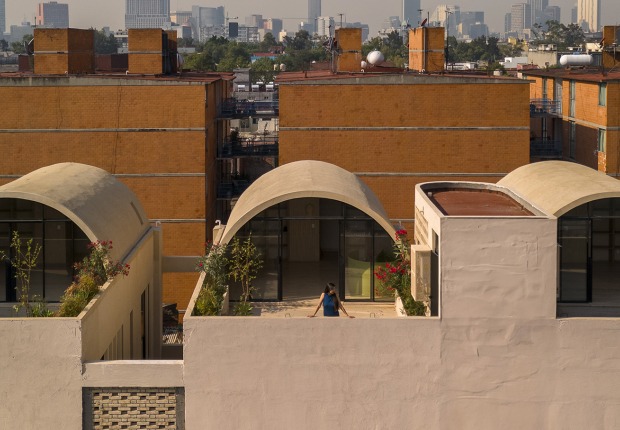The architect Francois Blondel, who was born in Paris in 1717, was given the task by the government in 1764 of creating new roads in Strasbourg to contain the traffic that had been increasing as a result of tourism, and of constructing on the main square a building that would serve as an example or the style of that period. On 15 July 1764 Blondel arrived in Strasbourg with his assistants, the surveyor Lothe and the engineer Boutter. The enormous building, which filled almost the whole of the northern side of the Place Kléber, was completed in 1767. Blondel was called the straightener and, in fact, he had reduced to a more or less straight facade the building that encroached too much upon the square. The whole of the building was used for military purposes (officers’ quarters, guard room, armory, etc.). The name ‘aubette,’ originally ‘obet’ derives from ‘aube’ (dawn), because orders were issued from here at dawn.
In 1840 the Kléber monument was inaugurated. In 1845 the most fashionable cafe, the Café ‘Cade,’ was opened in the aubette and in 1867 one of the rooms, now a cinema ballroom, was transformed into a concert hall. For a long time the city’s School of Music was established here. In 1869 the aubette became the property of the City of Strasbourg. A number of rooms were arranged as an art gallery. They contained works by Schongauer, Memling, Perugino, Correggio, Ribera, da Vinci, etc. In 1870 the whole gallery was destroyed by fire. Before the war, in 1911, the city proposed a radical remodeling, not only of the aubette, but of the whole square. Forty-six architects were invited to collaborate, but the plans, which are in the municipal archives, were never carried out. The aubette remains a building of mediocre appearance.
In 1922 Messrs Paul and Andre Horn and Ernest Heitz took a ninety-year lease of the right-hand wing of the aubette, but the city made a condition that no modification should be made to the facade, which is regarded as a ‘historical monument.’
One of the lessees, Mr Paul Horn, himself an architect, had the foundations restored and inserted a number of small rooms, to his own designs. All that remained of the old aubette were the facade, roof and columns. Consequently, the aubette no longer has it’ definitive form. At first, no one knew what to do with this colossus and the plans, which were made during the first four years by several architects and interior decorators, were not carried out. The aubette traversed on paper all the variations of style from Empire to Biedermeier.
In September 1926 Theo Van Doesburg entered for the first time into direct contact with the aubette through Mr Arp as intermediary. The Messrs Horn invited him to Strasbourg and he found there the possibility of executing on a large scale his ideas in the field of the construction of interiors and of transforming one of the finest rooms into the modern idiom. Mr Paul Horn, in whom he found an advocate of his ideas, persuaded him to set up an office on the Place Kléber. He first had to make new plans which would, in the nature of things, correspond with the uses of the different rooms. These plans were agreed by Messrs Horn and Heitz without any fundamental changes.
These preliminary plans, in which the function of the whole building was established, bore the stamp of a large-scale establishment of the kind to be found in large cities. He imagined a kind of ‘house of passage,’ in which the use of the various rooms would not be too strictly defined. On the first floor he wanted to link the large hall with the cinema-ballroom by means of a foyer bar. In this way the public would be able to follow the film in the cinema-ballroom without having to remain in the room itself. This fluidity, as I imagined it, was already given by the arcade on the ground floor which connected the Place Kléber with the Rue de la Haute Montée To the left of the entrance he had a location plan erected which enables the visitor, by means of words and signs, to orientate himself more easily. The same location plan has also been put up in the different rooms.
Arrangement of the Rooms
On the ground floor there are: 1 arcade, 2 café-brasserie, 3 café-restaurant, 4 tea room, 5 Aubette Bar, 6 stairs leading to telephone booths in the basement, 7 ladies’ and gentlemen’s toilets, 8 cloakrooms, 9 American Bar, 10 cellar for dancing and cabaret.
A large staircase leads to the upper floors.
On the mezzanine floor there are: 11 toilets, 12 cloakrooms, 13 billiard rooms.
On the first floor: 14 the large hall, which is also used for dancing and cabaret, 15 large banqueting hall, which is connected by a foyer to 16 small banqueting room. The kitchen and refrigerator are located in the mezzanine, while the kitchen offices are at the back, towards the Cour de l’Aubette, where there is also a service lift.
The other floors are used for offices and staff quarters, as well as for pantries, etc.
Materials
His original intention was to use exclusively durable materials, but because of expense he was obliged to restrict myself and use instead illusionist materials, such as color, as a means of expression.
The use of wood has been avoided as far as possible and concrete has been used in its stead for walls and fixtures such as the bar tables. All the doors have been made from large squares of glass, framed in iron. The windows separating the passage from the tea room and the Café rise uninterrupted to the ceiling, giving the maximum light and view to the interior. The lighting demanded a special study. It is inspired by the particular use of each room. He tried to achieve a regular full lighting which, nevertheless, would not dazzle the eyes and would avoid shadows. Centralized lighting has been abolished completely. Direct lighting has been installed in the small and large banqueting halls, in the tea room and in the passage indirect lighting in the café-brasserie, the restaurant and the cinema-ball room. The direct lighting in the large banqueting hall is in the form of large enamel sheets into which light bulbs have been fitted (16 bulbs in a square 4 ft X 4 ft). The same dimension of 4 ft X 4 ft is used for the ventilators. In the cinema-ballroom, the lighting takes the form of reflectors attached to nickel tubes. He originally wanted to light the rooms with neon but I had to abandon the idea, because this kind of lighting does not yet give satisfactory results for white light. In the café-restaurant and the brasserie, he also used lighting on aluminium sheets, which, when placed on walls next to the mirrors, gives very lively effects. The tables, chairs, sofas and other accessories are mass-produced. In these pieces of furniture, as in the cupboards, etc., there has been no attempt at artistic effects.
Painting
The painting of the ceiling and walls in the large banqueting room on the first floor and in the cinema-ballroom has been carried out in relief. There were two reasons for this: firstly, because in this way he achieved a better defined surface and avoided clashing of the colors; secondly, because the fusion of the two colors was absolutely impossible.
Large banqueting hall: the surfaces are separated by bands 12 in. wide and 1 ¼ ft deep. Light and color were of primary importance here in relation to function. They have given a form to the ‘fixed furniture’ of the room and are incorporated into it. For the subdivisions he took as a starting point a 4-ft module, this being the height of the radiators and of the grey ‘neutral’ zone of the balustrade. The smallest color surface here measures 4 ft X 4 ft, while the largest ones always represent a multiple of 4 ft X 4 ft plus the width of the band (12 inches). For a height of 4 ft up from the floor, he employed a neutral zone, which he also repeated in a vertical direction, making it possible to install clocks, batteries of electric switches, etc., without harming the impression of the whole. The lighting sheets as well as the ventilator grilles have been made to form an organic part of the composition. (The color composition is based upon dissonances).
Cinema-ballroom
It was very difficult to animate this room by the use of colors. He did not have any unbroken surface at my disposal. The front wall was interrupted by the screen and the emergency exit, the rear wall by the entrance door, by the door of the small banqueting hall and by the openings for the cinematic projectors, as well as by the reflector. The left-hand wall was broken up by the windows extending almost to the ceiling, and the right-hand wall by the door to the kitchen offices. Now, since the architectural elements were based upon orthogonal relationships, this room had to accommodate itself to a diagonal arrangement of colors, to a counter-composition which, by its nature, was to resist all the tension of the architecture. Consequently, the gallery, which crosses the composition obliquely from the right-hand side, was an advantage rather than a disadvantage to the whole effect. It accentuates the rhythm of the painting.
The surfaces are raised l ½ in. above the plaster and separated from one another by bands l ½ in. deep and 14 in. wide. If he were asked what I had in mind when he constructed this room, I should be able to reply: to oppose to the material room in three dimensions a super-material and pictorial, diagonal space.
The painting of the Café and the restaurant on the ground floor has been as far as possible directly harmonized with the fittings, the materials and the light. Color as pigment will always remain an illusionist substitute for obtaining an effect which is really produced only by the practical and aesthetic qualities of materials.
The Aubette was conceived to be a work of total art applying the esthetic theories of «De Stijl», the movement founded by Theo van Doesburg and Piet Mondrian in 1917.
Too avant-garde for the public’s taste, most of the Aubette decors were modified, and later destroyed in the latter part of the 30’s.
The radical interiors of the Café l’Aubette, while now lauded as a masterpiece of De Stijl architecture, were not met with great acclaim by the café’s patrons. After less than a decade, the interior style was altered once again; it was not until the 1960s that restoration of Van Doesburg’s design was even considered. The ciné-dancing hall was restored between 1985 and 1994 based on period photographs and architectural drawings; the rest of the interior followed later, with the emphasis being on conservation of the original materials wherever possible. Meticulous care was taken to reproduce exactly the colors chosen by Van Doesburg and the Arps, and by 2006, the Aubette was restored to its 1920s appearance. Now designated a historic landmark, the Café l’Aubette remains a monument to the marriage of graphic design and architecture facilitated by De Stijl’s principles of bold geometry.
In 1926 van Doesburg, with artists Jean Arp and Sophie Taeuber, obtained the commission to refurbish the interior of a mid-eighteenth-century building to create Café Aubette—large restaurant with a cinema and dancehalls.
More information
Published on:
November 18, 2016
Cite:
"Cafe Aubette or how to inhabit a painting" METALOCUS.
Accessed
<https://www.metalocus.es/en/news/cafe-aubette-or-how-inhabit-a-painting>
ISSN 1139-6415
Loading content ...
Loading content ...
Loading content ...
Loading content ...
Loading content ...
Loading content ...
Loading content ...
Loading content ...
Loading content ...
Loading content ...
Loading content ...
Loading content ...
Loading content ...
Loading content ...
Loading content ...
Loading content ...
Loading content ...
Loading content ...
Loading content ...
Loading content ...
Loading content ...
Loading content ...
Loading content ...
Loading content ...
Loading content ...
Loading content ...
Loading content ...
Loading content ...
Loading content ...
Loading content ...
Loading content ...
Loading content ...
Loading content ...
Loading content ...
Loading content ...
Loading content ...
Loading content ...
Loading content ...
Loading content ...
Loading content ...
Loading content ...
Loading content ...
Loading content ...
Loading content ...
Loading content ...
Loading content ...
Loading content ...
Loading content ...
Loading content ...
Loading content ...
Loading content ...
Loading content ...
Loading content ...
Loading content ...
































![Frederick (then Friedrich) Kiesler's City of Space [Raumstadt] debuted at the Exposition des Arts Décoratifs in Paris, 1925 Frederick (then Friedrich) Kiesler's City of Space [Raumstadt] debuted at the Exposition des Arts Décoratifs in Paris, 1925](/sites/default/files/styles/mopis_home_news_category_slider_desktop/public/images-lead/G.jpg?h=5c5ad3f7&itok=2bsigA7w)







